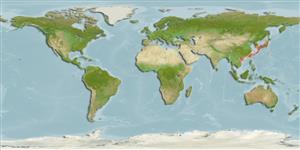Common names from other countries
Environment: milieu / climate zone / depth range / distribution range
Ecology
Marine; reef-associated; oceanodromous (Ref. 51243); depth range 1 - 30 m (Ref. 9710). Subtropical
Northwest Pacific: around Ryukyu, Bonin, and Izu islands and the main islands of southern Japan.
Size / Weight / Age
Maturity: Lm ? range ? - ? cm
Max length : 15.0 cm TL male/unsexed; (Ref. 559)
Inhabit clear and outer waters; usually more than 10 meters deep. Adults form schools of more than 10 individuals and migrate over a wide area. Oviparous (Ref. 205). Form pairs during breeding (Ref. 205). Occasionally kept in captivity by Japanese aquarists but is rarely exported.
Life cycle and mating behavior
Maturity | Reproduction | Spawning | Eggs | Fecundity | Larvae
Form pairs during breeding (Ref. 205).
Allen, G.R., 1985. Butterfly and angelfishes of the world. Vol. 2. 3rd edit. in English. Mergus Publishers, Melle, Germany. (Ref. 4858)
IUCN Red List Status (Ref. 130435)
CITES (Ref. 128078)
Not Evaluated
Threat to humans
Harmless
Human uses
Aquarium: commercial
More information
ReferencesAquacultureAquaculture profileStrainsGeneticsElectrophoresesHeritabilityDiseasesProcessingMass conversion
Tools
Special reports
Download XML
Internet sources
Estimates based on models
Preferred temperature (Ref.
115969): 19.2 - 26.3, mean 22.6 (based on 166 cells).
Phylogenetic diversity index (Ref.
82804): PD
50 = 0.5000 [Uniqueness, from 0.5 = low to 2.0 = high].
Bayesian length-weight: a=0.02291 (0.01133 - 0.04632), b=3.00 (2.83 - 3.17), in cm Total Length, based on LWR estimates for this Genus-body shape (Ref.
93245).
Trophic level (Ref.
69278): 3.5 ±0.4 se; based on diet studies.
Resilience (Ref.
120179): High, minimum population doubling time less than 15 months (Preliminary K or Fecundity.).
Fishing Vulnerability (Ref.
59153): Low vulnerability (10 of 100).
